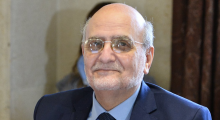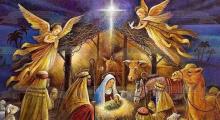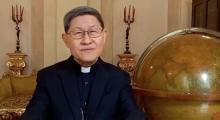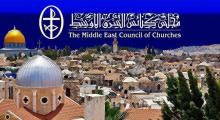Issued by the Catholic Center for Studies and Media - Jordan. Editor-in-chief Fr. Rif'at Bader - موقع أبونا abouna.org
Eleven works from the Vatican Apostolic Library are featured in the second Islamic Arts Biennale, held from January 25 to May 25 in Jeddah, Saudi Arabia. They include ancient translations of the Quran, texts on astronomy, and a unique, almost six-meter-long, 17th-century map of the River Nile, restored for the occasion.
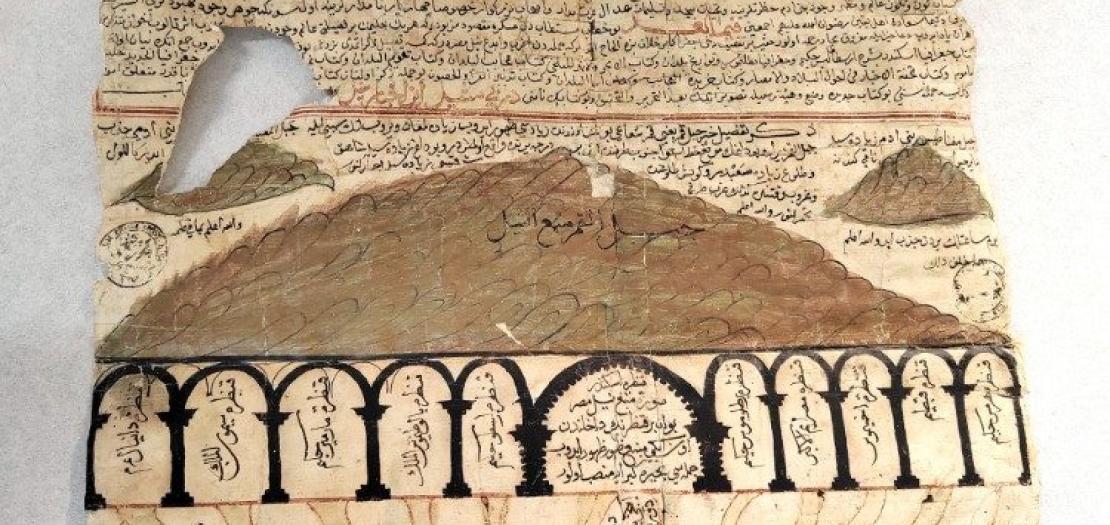
The map of the Nile before restoration
“To return to the origins of humanity, to rediscover the roots of history, and to heal the present from the wounds of hatred and division.” This is how Archbishop Angelo Zani, Archivist and Librarian of the Holy Roman Church, described the Vatican Apostolic Library's participation in the Al-Madar section of the Islamic Arts Biennale, which runs from January 25 to May 25, 2025, in Jeddah, Saudi Arabia. The theme of the exhibition, “And All That Is In Between,” is inspired by a phrase that appears approximately 35 times in the Qur'an. It refers to God's creation of the heavens, the earth, and “all that is in between,” highlighting the absolute and all-encompassing majesty of creation.
Arts, faiths, and cultures in dialogue
The Biennale, structured into seven sections (AlBidaya, AlMadar, AlMuqtani, AlMathala, Makkah al-Mukarramah, Al-Madinah al-Munawwarah, and AlMusalla), offers a unique opportunity to admire artifacts from Islamic holy sites such as Mecca and Medina, alongside pieces on loan from over thirty international institutions across twenty countries. The exhibition is set within the iconic Western Hajj Terminal of King Abdulaziz International Airport, through which millions of Muslim pilgrims pass annually.
In the AlMadar section, the Vatican Apostolic Library presents significant works in alignment with the goals of the event, organized by the Diriyah Biennale Foundation. These goals include “promoting the diversity of artistic expressions that characterize Islamic arts globally and fostering understanding and collaboration among diverse cultures.”
Numbers and calculations
Spanning 110,000 square meters of exhibition space, the AlMadar section (“The Orbit”) explores the representation of numbers in collective history, touching on the origins of natural calculations, their applications in Islamic culture, mathematics, architecture, music, design, celestial and terrestrial mapping, ocean navigation, trade, and geometric patterns in Quranic decoration.
The Library of Humanity
“In 1451, Pope Nicholas V founded the Vatican Apostolic Library to make texts and volumes available to researchers and scholars. From its inception, it wasn’t designed solely as a theological Christian library but as a library of humanity,” Zani explains. “Rooted in humanism, our institution continues to embody these values. When we received the invitation to Saudi Arabia, we found ourselves in an interreligious and intercultural context. Our treasures are unique, and we must use them to build cultural diplomacy and dialogue, fostering conversations even between differing perspectives on what humanity has produced. Humanity’s roots are unified, not fragmented.”
The six-meter map of the River Nile
The Vatican Apostolic Library’s contribution to the Jeddah Biennale includes 11 works, marking the second edition of the event, which attracted over 600,000 visitors in 2023. Among the items, the highlight is a nearly 6-meter-long map of the Nile. It was displayed during a 2021 Vatican Library exhibit and is now leaving the Vatican walls for the first time. “This map, dating to the late 17th century, was acquired in 1739 in Constantinople by the Lebanese librarian, Giuseppe Alemanni, who later became the Vatican Library’s Prefect,” says Delio Vania Proverbio, an expert on Oriental texts at the Vatican Apostolic Library.
Evliya Çelebi’s journey
"It was acquired in 1739 in Constantinople by the Lebanese Giuseppe Alemanni, who in 1736 became the Prefect of the Library and kept this map in his collection. It directly refers to the work of a famous Ottoman traveler, Evliya Çelebi, who crossed Egypt, from Cairo to the sources of the Nile, in 1683" recounting the details of "the most extensive journey undertaken across the entire Ottoman Empire at the height of its expansion, in the ten volumes of his famous travel book," the Siyāḥat-nāme. The texts in Ottoman Turkish on the map correspond exactly to what he recorded in his diaries.
"The map," Delio Proverbio continues, "can be dated around 1685 and is displayed at the Jeddah Biennale in a single setting alongside a sister map, likely produced in the same workshop, depicting the Persian Gulf. This map is now housed in the collection of the National Library of Qatar."
The restoration
Before being sent to Jeddah, the map of the Nile underwent a meticulous restoration funded by the Saudi government and carried out by the Restoration Laboratory of the Vatican Apostolic Library. The map was drawn with water-color ink on Venetian paper with a “three moons” watermark and is exceptionally detailed. In its representation of the territory watered by what is considered one of the world’s longest rivers, symbolic landmarks such as the Pyramids of Giza, Saint Catherine’s Monastery on Mount Sinai, the Cairo aqueduct, and Mount Horeb—where Moses received the Tablets of the Law—are depicted in a highly compressed latitude.
The conservation work removed the remnants of the canvas to which the map had been affixed in past centuries, as well as the Japanese paper applied in the 1980s. After repairing entomological damage, the restorers mounted the map on a new Japanese paper support.
A study opportunity
Leading the Restoration Laboratory of the Vatican Apostolic Library, founded at the end of the 19th century and described as "one of the oldest restoration facilities within a library," is Ángela Núñez Gaitán. "The modern concept of book restoration," she explained to Vatican media, "was born within this laboratory and has evolved significantly over the past century.
Restoration is always an opportunity for study. We have thousands of works requiring intervention, but when one is selected for an exhibition, it takes priority. The restoration of the Nile map allowed us to study this marvelous document.
"We reintegrated the missing areas, repaired the tears, and flattened the map's surface using the ‘false margins’ technique. Then we carried out the cleaning process, removing residues of animal glue with the help of enzymes. Finally, we retouched the integrated areas, and the work has reemerged in all its beauty," revealing "certain graphic elements that were previously almost impossible to discern."
Precious translations of the Quran
Other volumes selected for the Islamic Arts Biennale have also undergone meticulous restoration by Vatican conservators. Among them are several precious translations of the Quran. "Consider the concept of the text's inviolability, which is fundamental in Islam: not a single comma may be altered," notes the Scriptor Orientalis of the Vatican Apostolic Library. "Heading to Jeddah are some unique manuscripts: a Greek translation, the oldest tradition compared to those in other languages. A Latin translation by a 7th-century author, who, with polemical intent, sought to analyze the Muslim faith by employing what is perhaps the most intelligent approach: reading the text and presenting counter-theses."
Notes by Pico Della Mirandola
Lastly, there is "a Quran written in Arabic using Hebrew script," adds Delio Proverbio, "intended for reading within the Jewish community. Likely written in Sicily in the 14th century, this manuscript was brought to Rome by a converted Jew, the intellectual Flavius Mithridates, and became the tool through which intelligentsia and humanists of the late 15th century learned Arabic."
The text features annotations by various figures, including Pico Della Mirandola. Additionally, "Flavius Mithridates began translating the text into Latin. There is interlinear red writing where this scholar comments on the Arabic text in Latin."
Numbers and stars
Medieval works on astronomy featuring the skies and constellations in the Ptolemaic view, as well as a book by Copernicus, are also displayed, highlighting that, as Frère Adrien de Fouchier (OP) of the Vatican Apostolic Library's Manuscripts Department notes, "there are no entirely isolated cultures."
"The Arabs preserved and expanded upon astronomical knowledge from both Asia and ancient Greece, and their work resulted in translations into Western languages," he continues. "An example on display at the Biennale is a manuscript written in Arabic and translated into Greek."
Dialogue and exchange
"Numbers," Frère de Fouchier observes, "are closely tied to astronomy. The importance of zero in calculations is fundamental. A manuscript by Fibonacci, the first in Europe to introduce zero—brought from India via the Arab world—is also included in the exhibition. A printed text by Copernicus, with handwritten notes by one of his disciples, further illustrates how elements from various cultures contribute to the development of knowledge, approaches, and descriptions of the world."
Through dialogue and exchange, humanity as a whole is enriched. "A message that remains relevant even today," comments Frère Adrien.
Recovering the roots of history
The mind cannot but turn to the dramas affecting our world today, particularly the relentless violence in the Middle East. Archbishop Angelo Zani recalls the Pope's appeal to engage in dialogue and build peace in the world: "I believe libraries play a very important role in recovering the roots of history in order to live in the present without repeating the disasters we are sadly committing today."
Creating connections
The Vatican Apostolic Library's participation in the Islamic Arts Biennale aligns with the theme of hope, in continuity with the Jubilee 2025 theme, "Pilgrims of Hope." The pilgrimage, the Prefect of the Vatican Apostolic Library, Don Mauro Mantovani (SDB) emphasizes, is evocative "of the movement of peoples, including through the exchange of cultural heritage."
"We gladly embraced the perspective of providing materials related to numbers and calculations. A theme dear to Pope Francis, such as 'creating connections,' is also linked to numbers because it represents a relationship. In this sense," Mantovani concludes, "our presence in Jeddah is highly significant."


